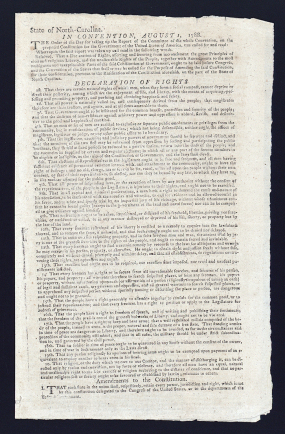
On December 17, 1776, the Fifth Provincial Congress at Halifax issued the North Carolina Declaration of Rights. Consisting of 25 articles, the document outlined the basic rights of citizens of the new state and became part of the state constitution, which was issued the following day.
The Declaration of Rights was the work of a 28-man committee chaired by the president of the congress, Richard Caswell, and it was modeled on English legal and political traditions. The first provision emphasized that all political power comes from and is vested in the people, and other articles:
- guaranteed free and frequent elections;
- prohibited excessive bail, fines and punishments;
- enshrined the right to a fair and speedy trial by jury;
- protected freedom of the press, assembly and worship;
- ensured taxation by public consent only;
- established the right to bear arms in state defense;
- placed the military under civil control; and
- barred the creation of laws with retroactive penalties.
Notably, at the time, these rights applied to free people only, and not to enslaved people.
In an ironic twist, the citizens of the state did not vote on either the Declaration of Rights or the new constitution. Instead, they went into effect on the authority of the congress.
For more about North Carolina’s history, arts and culture, visit Cultural Resources online. To receive these updates automatically each day, make sure you subscribe by email using the box on the right and follow us on Facebook, Twitter and Pinterest.
